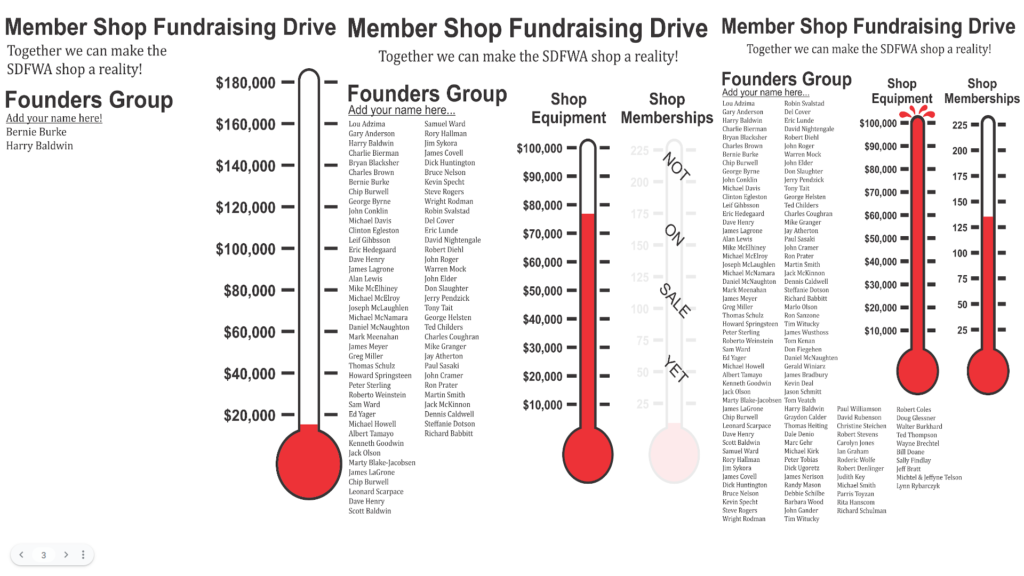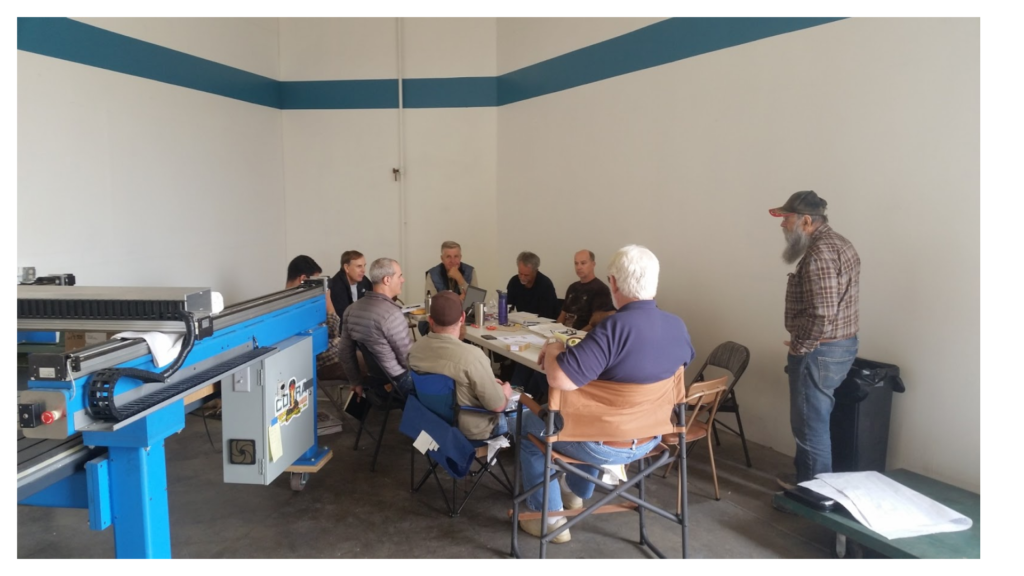The very beginnings of Shop were in 2014 – when there were a series of meetings devoted to long-range planning. While SDFWA as an organization was in fairly good shape with many successful activities – including the best woodworking exhibition in the US – some of us were worried about our stagnant membership numbers and trying to figure out how appeal to a wider variety of people, how to expand our education and mentoring offerings, and see if there were new activities that SDFWA members would want to participate in. And especially to create more opportunities to work together and build a stronger sense of community.
So many of the suggestions in the meetings rested on “if only we had a community shop”. Then there was a timely magazine article in Popular Woodworking about the Kansas City Guild Shop which posed a question for SDFWA leadership – if they can do it, why can’t we? It was quite a stretch – as there were entrenched opinions about insurance, finances, organization and staffing, fundraising, and more. But we looked and discovered three other woodworking guilds across the US who had shops – Kansas City MO, Greenville SC, and Portland OR. (And we’ve since discovered a couple more.) But the more we looked, and the more questions we asked, the answers kept coming back – why not?
SDFWA had previously tried to organize a Shop – but those efforts met with insurmountable difficulties. And there were a lot of things to worry about – but Gary Anderson and I decided to give it a real go. We had many months of planning lunches over beers, looking at rental properties, drafting a business plan, getting legal advice, figuring out fundraising, answering questions about how to protect existing SDFWA financial interests, surveying the SDFWA membership to see what kind of Shop tools and activities they were interested in, mapping what locations might work for most of our members, what should membership cost and what hours to be open – many questions for which we needed at least preliminary answers. The lunches started with Gary and me, but quickly expanded to include Pete Sterling. And all through 2015 the Shop plans started to take shape.
The biggest unknown was “How much money could we raise?” A goal of $180,000 sounded like a wild dream. Then we were motivated by seeing an exciting, feasible space – right in the complex where our Shop is located – but we weren’t ready yet. And there’s no possibility of telling a landlord “Just wait a year, and we’ll see if we can raise the funds.” We found out not all the industrial parks we looked at wanted a woodshop on their property, and we realized we needed money in the bank when a potential space opened up.

So at the beginning of 2016 we presented a business plan and fundraising strategy to the SDFWA Board and membership – here’s what we can do, here are the benefits of a Member Shop; if you want one – we need to have the $$$s in hand. If we raise enough – we’ll go ahead. If not, we’ll hold all the donations in escrow and refund it back to you. Then we watched the fundraising “thermometers” rise higher and higher. SDFWA members turned out to be very generous. The many people who helped start our Shop are all listed on the wall plaques in the entry hall of the Shop.

We also received some significant financial contributions from current SDFWA members and couple of people who had bequeathed funds to SDFWA in their will. I remember opening one particular envelope – then calling Gary and asking if he was expecting a donation like this. He was not, but for me, that was the moment that I knew the Shop was going to become a reality. We were nearing our fund-raising goals, but this pushed us close enough to be able to commit to the Shop project by the end of 2016, then sign our lease in February 2017 and start building. Besides, Ann really wanted me to get that big CNC machine – our first tool donation – out of our garage.


It’s been quite an adventure since then – the initial team expanded to include a lot more people – many of whom are still active in the Shop. There were work parties for building walls, painting, building cabinets, putting together tools and dust collector ducts, building Shop furniture, and much more. We needed to figure out how to train Shift Supervisors, how to start teaching classes, what hours we were going to operate, how to handle maintenance, and how to keep track of Shop memberships and shifts. There were dozens of things to do and almost enough people to do them. The Shop first opened its doors in June 2017, and in 2022 we celebrated its 5th anniversary. Gary was Shop Chairman and Pete was the first Shop Director, keeping things going and building up the team of people who are running the shop today. Some things we did well right from the beginning, others we changed and adapted, as we continue to do – Shop 3.0 will fix some of the Shop layout plans we didn’t get right the first time.
We also got help from the other guilds with shops. If you visit the Portland shop – like Gary and Pete and I did during the planning stages – you’ll see a rack of name tags on their wall that looks very much like ours. The idea for HOST was developed in Kansas City, who gave it to Portland, who then shared it with us. Gary also built up a network of woodworking guilds across the US who still share information and help each other out.

Another thing we learned in our exploration stages was that there’s not just one right answer for how a guild Shop works. Greenville had a system where all the guild members supported the Shop, and their facility included a meeting space, a small lumber yard, plus extra space they could rent out. Kansas City did projects for local businesses – running a kind of small woodworking business. Portland concentrated on education; they were teaching introductory woodworking classes even before they even had a shop. And they had a paper based PunchPass process that inspired our Shop Shifts scheduling system. So one thing we made sure of is that the SDFWA Member Shop had multiple ways to pay the rent – beyond our Shop Memberships. A couple of those have succeeded for us in a big way – like our Introduction to Woodworking class, and our annual Holiday Gift Sale. And we continue to improve and expand – with the completion of Shop 3.0 we expect to be hosting regular woodworking presentations and also hands-on seminars in the new, larger spaces.
A big addition to the Shop capabilities that was not in our original plans was our Digital Tools. While we had always envisioned a CNC router as a tool that most SDFWA members won’t have in their garage, Travis Good really pushed to build a great Digital Tools section of the Shop. These machines – CNC routers, lasers, and 3D printers – have become very popular offerings with Special Interest Groups (SIGs) and classes to support them. Maybe it’s not traditional woodworking, but there have been amazing things produced on our Digital Tools, and people have joined the Shop just to have access to them.

A major goal for establishing our Shop was to expand SDFWA’s education program. We have a long history of teaching – seminars, mentoring, skill-building sessions, General Meeting presentations and more. One of our chartered purposes is to educate the community in all aspects of woodworking. Starting with our extremely popular Intro to Woodworking class, the Shop education department has expanded to offer a long list of classes covering a wide variety of topics. And we are continuing to develop more classes all the time.
Another thing we focused on right from the beginning was to building a woodworking community – not just a shop space. Our goals included getting people together for woodworking, forming SIGs, setting up an education department, introducing new people to woodworking, and helping existing members learn new skills. Gary also emphasized customer service – making sure everyone worked together – members, supervisors, instructors, maintenance and support people – making a whole community. And I think we can all be very proud of what we’ve built. The Shop is currently kind of bursting at the seams, and we have long waiting lists of members wanting to take classes or join – we must be doing something right.
While Gary and Pete have stepped back from their roles as Shop Chair and Shop Director, Dallas, Rick, Sharon, Scott, and all the rest of the team have taken on the responsibilities of keeping the Shop running – including pulling off the amazing Shop 3.0 expansion in 2022. Looking around the new spaces, I see what we were envisioning several years ago – and it’s really happening. Gary’s most recent contribution to the future of the Member Shop was securing an extension of our lease for 3 more years, with our option of extending for another 3 years beyond that. I cannot overstate how much better off we are doing this expansion here – instead of trying to move to another place. I can honestly say that we have wildly exceeded all of the goals we originally had for the SDFWA Member Shop – and its future looks very bright indeed.
Jeff Bratt
SDFWA Historian

